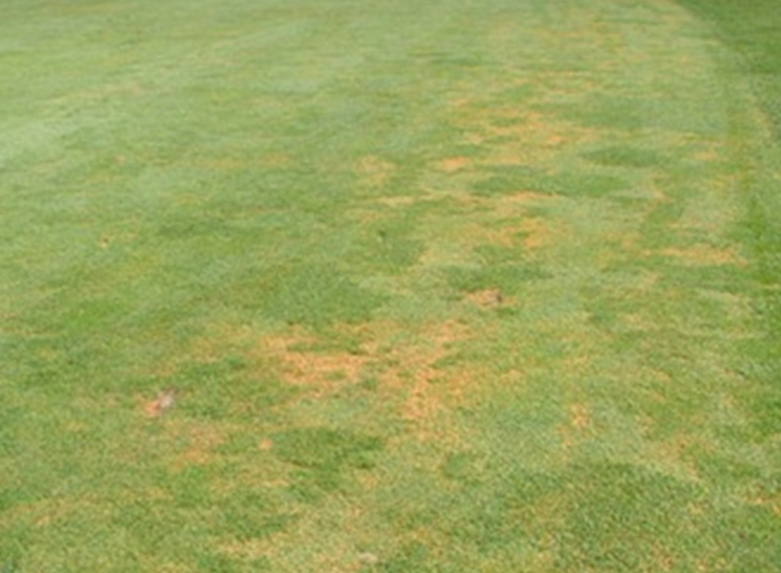Anthracnose, It’s A Very Difficult Balance

Over the past few years I have noticed a general increase in occurrences of anthracnose on some turf surfaces but not so much on others. I have been monitoring cases and there does seem to be a bit of a pattern, although not completely. The increase seems to be mainly attributed to golf greens and is comparably less occurring on croquet lawns or bowls greens. The demands by golfers since the big golf boom in the 80s (and again that we are seeing since the end of lockdown) has driven the desire for faster greens that are in tip top condition throughout the whole year. This is really something that is very difficult to achieve.
When I started greenkeeping back in the late 1970s, working on Golf greens, bowling greens and Croquet lawns, the maintenance regime of each was just the same. All 3 of these were summer sports and grass was cut from April to October at 3/16th inch (4.76mm) then rested in the winter with a maintenance cutting height for bowls and croquet 7/16th inch (11.2mm). Golf was played in the winter but not as it is now. Play would be from a rubber mat and normally to a winter green with a 6” hole cup. For the occasional winter competitions, the main greens may be brought back into play for the day, therefore the winter cutting height was 5/16th inch (8mm). Imagine trying to get away with that today!
Now as I draw up maintenance programmes for fine sports turf I still specify a summer cutting height of 5mm for both bowls and croquet. However, the constantly increasing demands for faster slicker golf greens often dictate a much reduced height of cut. We have all heard of greenkeepers cutting as low as 2mm or even lower on some occasions.
Turf cut at 3mm or below is under immense stress creating the ideal environment for anthracnose to take hold. Whilst it is easy for me as an advisor to say “Just raise the height of cut” I fully appreciate “it’s a very difficult balancing act”. The turf Manager need to try and keep both the players and his grass happy. Golf greens need to run at an appropriate speed for the golfers playing it yet not over stressed at periods when the likelihood of anthracnose is high.
Anthracnose mainly, but not exclusively, attacks (poa annua) annual meadow grass and is therefore sometimes left by greenkeepers to slowly reduce the amount of poa in the sward so that it can be replaced by bent grass. This is a useful tactic, however, unless you are regularly planting bent seed into the thinning surface the most likely grass to infill the space is more poa! Once the plant is infected with anthracnose it is incapable of recovery, this is a big danger. You may see early signs of anthracnose and leave it a while as it is only attacking the poa but, if unchecked it can quickly get a hold and you can lose large areas of poa on the green.
Generally the greens maintenance programmes I draw up now for customers have regular, small applications of a balanced Nitrogen and Potassium feed as keeping the plant with a readily available source of N&K can help drastically reduce the development of Anthracnose. Using NK liquids such as Prestige NK Spring Summer or Greenmaster NK allows low application rates.
There are a number of fungicides (Heritage WSG and Heritage Maxx, both have good control from late spring through to late summer. In spring and autumn Clayton Bestow has moderate control. For winter control its Medallion TL) that have approval for the control of anthracnose on greens and these are best used preventatively but for qualified advice on which one may be most suitable for your site, the time of year and for fungicide resistance management, speak to one of the Collier Turf Care BASIS & FACTS qualified advisors. The addition of Prestige Super Recovery to a fungicide adds balanced vital trace elements and reduces plant stress as well as containing a spreader to distribute the fungicide across the whole leaf, and also a rain fastener. Remember that you should not add anything to a fungicide unless it is approved and is registered as an adjuvant (look for the registered adjuvant number).
With a BASIS & FACTS qualified advisor, prepare an ITM (Intergraded Turf Management plan) for your turf. Look at reducing plant stress, include irrigation levels, keep the rootzone moist but the surface dry, and use a turf pigment such as Ryder to reduce UV damage, ensure adequate and appropriate nutrition, Potassium Silicate to strengthen the leaf and a preventative fungicide programme. Where possible, increase the height of cut, just 20% (for example, 3mm to 3.6mm) can make a big difference to reducing turf stress.
ICL have produced a comprehensive interrogated management leaflet for anthracnose prevention that can be accessed by on the Collier Turf care web site, click here.
Use the Collier Turf Care disease forecast (Click here to register and have this sent to you every week free) to see when anthracnose disease pressure is high.
By Chris Humphrey MBPR FQA, Technical Manager
For further expert help with worm casting and advice on the products to use, contact Collier Turf Care on 01328 700600